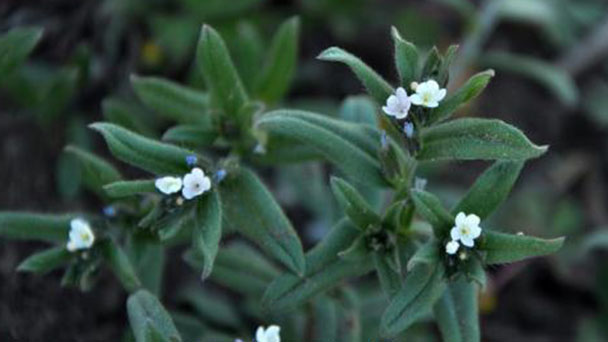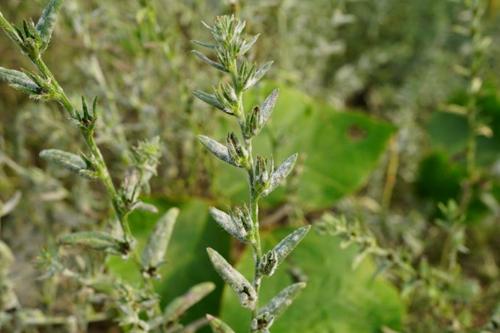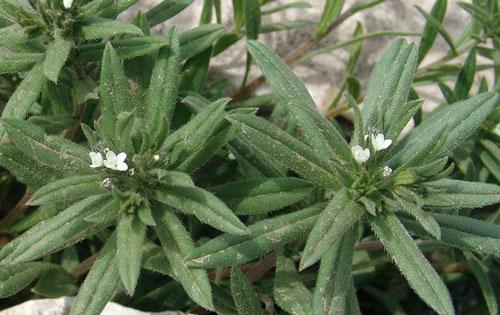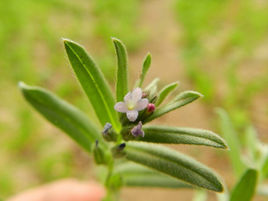Corn gromwell (Lithospermum arvense) profile
Written by Maggie
Aug 24 2021

Corn Gromwell (Lithospermum arvense), also called field gromwell, bastard alkanet, is a plant of the genus Corn Gromwell in the family. Corn Gromwell is distributed in Korea, Japan, Europe and in Hebei, Shaanxi, Anhui, Heilongjiang, Liaoning, Shandong, Xinjiang, Zhejiang, Shanxi, Gansu, Jiangsu, Hubei, Jilin and other places in mainland China. It can be seen on the grassy slopes of low mountains, hills or the edges of fields.
Corn Gromwell relies on seeds to propagate. When the seeds mature, they are spread by the wind or by sticking to animals. After a short time of dormancy, the newly mature seeds can germinate under suitable conditions, and the germination rate is more than 80%. corn gromwell is generally suitable for low hills, hills and slopes, shrubbery, plain wasteland, field edge, roadside, river and lake beach, beach, gravel hillside, and hilly field, etc.
Corn gromwell picture

Morphological characteristics of corn gromwell
Corn Gromwell is an annual herb with a slightly purplish root.
Corn Gromwell usually has a single stem, 15-35 cm tall, with short strigose hairs from the base or only the upper branches. Leaves are sessile, oblate late to linear, 2 -- 4 cm long and 3 -- 7 mm wide, apex acute, shortly strigose on both surfaces. Cymes are distally branched, up to 10 cm long, bracts homomorphic to leaves but smaller;Inflorescences sparsely arranged, short pedicels; Calyx lobes are linear, 4 -- 5.5 mm long, usually erect, with short overlying hairs on both surfaces, fruit up to 11 mm long and slightly late at base; Corolla is saltpeter-shaped, white, sometimes blue or pale blue, tube ca. 4 mm long, slightly hairy outside, leaves about half of the tube, lobes ovate or oblong, erect or slightly spreading, ca. 1.5 mm long, slightly unequal, throat without appendage, but with 5 hairs extending to the tube; Stamens are bearing proximal corolla tube, anthers ca. 1 mm; Style of Corn Gromwell is 1.5 -- 2 mm long, stigma capitulate. Nutlets are triangular-ovoid, ca. 3 mm long, grayish brown, verrucose.
The base of the stem or upper part of the root of Corn Gromwell is tinged with lavender. Leaves are narrowly lanceolate or ovate-elliptic, 1 -- 4 cm long, 3 -- 10 mm wide, apically obtuse, and basally narrow cuneate. Flowers have short stalks; Calyx lobes are linear; Corolla is white, 6 -- 7 mm long, hairy outside, throat unscaly; The stamens are born below the middle of the corolla tube. Nutlets are grayish white, with a narrow tip and a nodular surface.
Ecological habits of corn gromwell
Corn Gromwell (Lithospermum arvense) grows on dry hillsides, in grasslands, under trees, or among bushes. After the artificial domestication of cultivated varieties like cool, wet climate, fear of high temperature, avoid rain and drought, need sufficient sunshine, in full light growth.
Corn gromwell propagation
Sow
In autumn before freezing sowing seedling emergence rate is the highest, the disadvantage is winter, spring watch waste artificial.In the early days of April, a trench 7.5cm wide and 3cm deep was opened on the well-prepared plot, with row spacing of 18cm. After trampling, the seeds were evenly sown in the trench, and the soil was 1.5 ~ 3.0cm, and the soil was crushed. Full seedlings will come out about 25 days after sowing. If the flowering period meets the drought, to timely irrigation. The seeding amount is 30 ~ 37.5 kg/ ha.
Seed treatment
Corn Gromwell (Lithospermum arvense) seeds have to go through a low temperature stage before the embryo ripens. A number of seeds are sown in spring, and seedlings will not appear in that year. Before the severe winter, the harvested seeds should be soaked in warm water (20℃) for about 30 minutes, and then mixed with two to three times the amount of disinfected wet sand to ensure that the seeds absorb water adequately. Then, the seeds should be put into woven bags and placed in a leeward and shady place with high and dry terrain outside for freezing. It is better to cover it with snow and ice around it. After a hard winter of freezing treatment. Always pay attention to the prevention of rats. Most of the seeds will sprout in April of next year and be taken out to be sown.

Disease control of corn gromwell
1. Root rot occurs in high temperature and wet season, and mainly harms the root. Pay attention to drainage, and dig out the infected plant in time when it is found, and infuse the sick point with 0.01 ~ 0.02 g/ L ferrous sulfate. When the leaf spot comes on, spray with an equivalent amount of Bordeaux liquid. Carbendazim 200 - fold solution can be used to control seedling blight.
2. The occurrence of insect pest aphid can be controlled by dimethoate. Underground pests such as Ji Ta, mole cricket, and tigers can be used to kill poisonous soil bait.
Corn gromwell's area of distribution
Corn Gromwell was produced in Heilongjiang, Jilin, Liaoning, Hebei, Shandong, Shanxi, Jiangsu, Zhejiang, Anhui, Hubei, Shaanxi, Gansu, and Xinjiang provinces.Raw hills, low mountain grassy slopes or the edge of fields.North Korea, Japan, Europe.
Uses of corn gromwell
The economic value
Corn Gromwell (Lithospermum arvense) can also be used as the best natural food pigment and the raw material of cosmetics due to the rich purple pigment in the root of Corn Gromwell, which is non-toxic and tasteless. It can also be used in medicine, printing and dyeing industries.Its seeds can be extracted from high - grade industrial oil or edible oil, which has a good value of development and utilization.
Forage value
Corn Gromwell is a weak plant with soft stems and leaves, rich nutrition, non-toxic and no strange taste. However, the whole plant is covered with coarse hair, which affects the feeding effect. All kinds of livestock and poultry can be used except horses. Camels like food, sheep, goats happy food, cattle a small amount of food, can be used all year round. After the young stem and leaves are chopped, pigs, rabbits, chickens, ducks and geese are fond of eating. Corn Gromwell can also be eaten by humans. The seed oil after the oil is rich in nutrition, can be used as concentrate feed, all kinds of livestock and poultry are direct food.
Corn gromwell before flowering, crude protein, crude fat, nitrogen free extract content is high, equivalent to that of leguminous forage quality, alfalfa, fruiting, crude protein, crude fat content decreased obviously, crude fiber and nitrogen free extract was increased obviously, visible, before flowering, the most reasonable use, its chemical components are shown in table 143-1. According to the book "Northwest Oil Plants", the oil content of fruit oil is 21.5%, and the oil content of seed kernel is more than 50%. Gansu Lingtai and other places with indigenous oil, its oil yield is also 18% to 20%. For the sex of oil, oil fragrance.Iodine value is 202.95.
The digestible crude protein and energy value of Corn Gromwell (Lithospermum arvense) during the seed setting stage were slightly lower, which could only reach the level of medium forage. In conclusion, Corn Gromwell is a good forage. It can be mown at the tender stage and used as forage for pigs and poultry. The mature seeds can be used as concentrate feed.

Latest Updated
- Benefits of Bugleweed - 7 Science-backed Health Benefits
- Bugleweed Dangers & Side Effects - Is It Poisonous?
- How to Plant Evergreen Trees - What You Should Know
- When to Plant Evergreens - Grow Guide for Evergreen Trees
- 12 Wonderful Evergreen Shrubs for Your Garden
- 12 Popular Evergreen Plants with Pictures for Beginners
- When And How To Prune A Lilac Bush Like a Pro
- How to Grow & Care for Lilac Vine (Hardenbergia Violacea)
- Japanese Lilac Tree (Syringa Reticulata) Care & Propagation Guide
- Shumard Oak Pros and Cons - What to Know
Popular Articles
- Winter maintenance of Antirrhinum Majus
- How to Grow Terminalia Mantaly Tree
- How to Grow and Care for Crossostephium Chinense
- How to grow Antirrhinum Majus in spring
- Peristeria Elata (Dove Orchid) Profile: Info & Care Guide
- Underwatered Snake Plant (Sansevieria Trifasciata) - Signs And How To Fix
- How to Care for Brazilian Jasmine Plant (Mandevilla Sanderi)
- How to Grow & Care for Graptopetalum Purple Delight in Summer
- Rosa Chinensis (China Rose): Plant Growing & Care Tips
- How to Care for Baby Sun Rose (Aptenia Cordifolia)